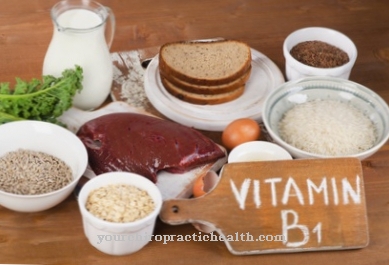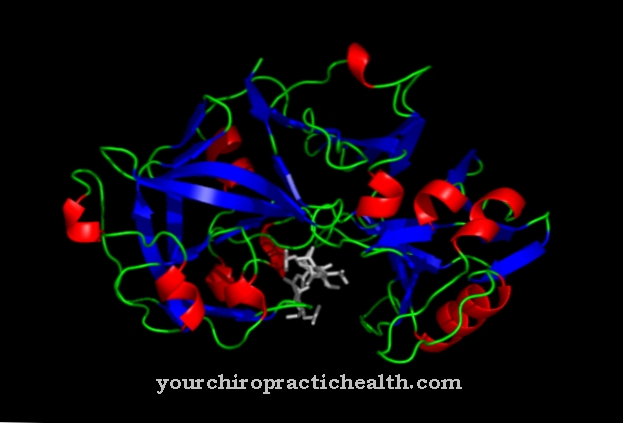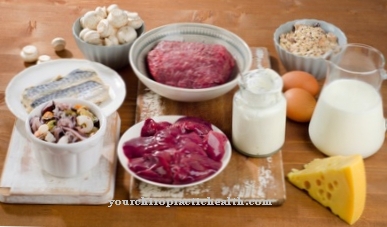Cobalt is a chemical element and belongs to the so-called iron-platinum group. It often occurs with nickel and iron. Biologically, it plays a major role as the central atom of vitamin B12.
What is cobalt
Cobalt is an iron-like metal with the atomic number 27. The name cobalt comes from the Latin and means goblin. Cobalt used to be held as valuable silver or copper ore.
However, since it could not be processed and because of its arsenic content gave off foul-smelling vapors when heated, the miners called it Kobold. The metal is rare in the earth's crust compared to other elements. In nature it is always associated with nickel. Cobalt is a trace element that occurs in most soils. There are some cobalt ores that have formed through weathering processes. However, its yield in sulphidic ores is very low at only 0.1 to 0.3 percent.
Elemental cobalt is a tough heavy metal that occurs in two modifications. Like all metals, cobalt conducts electricity and heat very well. In the air it is passivated by a superficial oxidation layer. Cobalt can form complex compounds with organic molecules. A typical example is cobalamin (vitamin B12).
Function, effect & tasks
Cobalt is extremely important for the human organism in the form of complex compounds, also known as cobalamins. The cobalamins represent the vitamin B12 group. Here, a cobalt atom acts as the central atom of a complex with six ligands.
The cobalt atom is surrounded by the four nitrogen atoms of a corrin ring. A fifth nitrogen ligand comes from a 5,6-dimethyl-benzimidazole ring, which is bonded to the corrin ring in a nucleotide manner. The sixth ligand is interchangeable and is responsible for differentiating the various cobalamins. The only active form of vitamin B12 is the complex adenosylcobalamin. Adenosylcobalamin is also the coenzyme B12. The cobalamins are the only known organometallic compounds in which cobalt plays an important role in biological processes. Vitamin B12 acts as a coenzyme for two enzymatic processes. It is involved in the conversion of homocysteine to methionine.
Homocysteine is methylated in the process. This reaction is a central part of all methylation reactions. The other enzymatic reaction helps break down odd numbered fatty acids and some amino acids into succinyl-CoA. This compound is an intermediate in the citric acid cycle. Cobalamins cannot be produced in the human organism. Therefore, humans are dependent on ingestion through food. Vitamin B12 is produced in the colon by intestinal bacteria. However, it can only be absorbed in the small intestine, so that the cobalamin synthesized in the large intestine has no physiological significance.
Vitamin B12 is stored in the liver. From there it reaches the small intestine via the bile acids and is absorbed there in the ileum by the intrinsic factor. In this way, the body's own needs can be covered for years with a reduced intake.
Education, occurrence, properties & optimal values
Cobalt is contained in its biologically active form in vitamin B12 in all foods that are of animal origin. Purely plant-based foods do not contain enough cobalamin. The biosynthesis of the vitamin is carried out by bacteria. Herbivores meet their needs with a special intestinal flora.
Humans cannot utilize the cobalamin produced in the large intestine because it is formed below the ileum. Here it is excreted unused. However, herbivores are also dependent on pastures with a sufficiently high cobalt concentration. Therefore, cobalt compounds must be added to the feed of the animals in soils poor in cobalt. A cobalt deficiency manifests itself in the animals as increasing anemia because vitamin B12 can no longer be formed in sufficient quantities.
Diseases & Disorders
Anemia can also develop in humans due to a lack of vitamin B12. However, this deficiency cannot be remedied by adding cobalt. As already mentioned, the vitamin B12 produced by bacteria in the human large intestine is not used.
Humans are dependent on the intake of cobalamin in food. Since animal foods are the main source of cobalamin, vegetarians are also dependent on vitamin B12 supplements. However, cobalamin has a half-life in the body of 450 to 750 days. It is stored in the liver and can be taken up again and again via the intrinsic factor. The stored supplies in the liver are therefore sufficient for a few years, even if the supply is limited. Humans have a daily requirement of 3 micrograms. Anemia develops when there is an actual deficiency in vitamin B12.
In addition, psychological problems develop, which are due to a disruption of the posterior cords and the pyramidal tract. In addition, the blood concentration of homocysteine increases because its methylation to methionine comes to a standstill. Elevated homocysteine levels promote the development of arteriosclerosis. At the same time, the methyl group donor N5-methyl-tetrahydrofolate (N5-methyl-THF) can no longer be converted back into THF (tetrahydrofolate). Among other things, THF is responsible for the formation of nucleic bases, so that nucleic acid formation is also inhibited.
As a result, blood formation is delayed and the few red blood cells are still overloaded with hemoglobin. Anemia has developed, which can be remedied by administering folic acid or, better still, vitamin B12. If the absorption of vitamin B12 is impaired due to the lack of the intrinsic factor, pernicious anemia occurs.




























